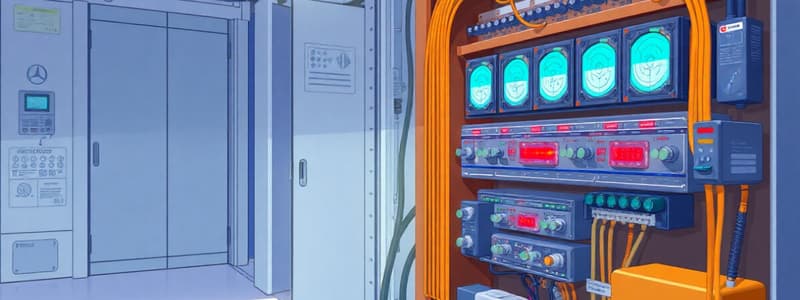Podcast
Questions and Answers
What type of fuse system is to be provided for the vital circuit?
What type of fuse system is to be provided for the vital circuit?
- Old type of fuse
- High-capacity fuse
- Approved type fuse auto change over system (correct)
- Manual changeover fuse system
Air conditioning is mandatory for signalling installations with how many routes?
Air conditioning is mandatory for signalling installations with how many routes?
- More than 100 routes (correct)
- Over 200 routes
- Any number of routes
- Only for E.I installations
Which conditions justify the provision of air conditioning for installations with less than 100 routes?
Which conditions justify the provision of air conditioning for installations with less than 100 routes?
- High route density
- Poor ventilation
- External temperature fluctuations
- Presence of dust or harmful fumes (correct)
What system may be provided at all stations irrespective of the number of routes?
What system may be provided at all stations irrespective of the number of routes?
What is the requirement for firefighting equipment in relation to the power supply equipment room?
What is the requirement for firefighting equipment in relation to the power supply equipment room?
Which installations must have data loggers provided?
Which installations must have data loggers provided?
What is the purpose of having suitable standard earthing for control panels and power supply systems?
What is the purpose of having suitable standard earthing for control panels and power supply systems?
Which of the following is a condition under which an Automatic Fire Suppression System may be provided?
Which of the following is a condition under which an Automatic Fire Suppression System may be provided?
What is the recommended wire size for connections to circuit breakers?
What is the recommended wire size for connections to circuit breakers?
What should be included to help identify terminals and tags?
What should be included to help identify terminals and tags?
How much additional capacity should relay racks have for future expansions?
How much additional capacity should relay racks have for future expansions?
What type of fuse is preferred for use in circuits?
What type of fuse is preferred for use in circuits?
What should be the visual indication when a fuse blows?
What should be the visual indication when a fuse blows?
How should fuse groups be arranged to minimize impact on train operations?
How should fuse groups be arranged to minimize impact on train operations?
What should be used for terminal blocks and tag blocks unless specially permitted otherwise?
What should be used for terminal blocks and tag blocks unless specially permitted otherwise?
How should fuses be arranged to aid in fault localization?
How should fuses be arranged to aid in fault localization?
What is the minimum size for single core conductors used in the internal wiring of relay racks?
What is the minimum size for single core conductors used in the internal wiring of relay racks?
Which type of wiring is required for connections to plug-in non-proved type relays?
Which type of wiring is required for connections to plug-in non-proved type relays?
What should be used for terminating the connecting wires in the internal wiring of relay racks?
What should be used for terminating the connecting wires in the internal wiring of relay racks?
What type of cable should be used for rack to rack wiring?
What type of cable should be used for rack to rack wiring?
What is the insulation type required for the conductors in internal wiring?
What is the insulation type required for the conductors in internal wiring?
How should the cable/entry arrangements be sealed after completing the wiring?
How should the cable/entry arrangements be sealed after completing the wiring?
What is the maximum rating for the flame-retardant PVC insulated wire used?
What is the maximum rating for the flame-retardant PVC insulated wire used?
Which of the following is NOT a requirement for wiring in a cabin and locations?
Which of the following is NOT a requirement for wiring in a cabin and locations?
Flashcards
Relay Rack Wiring Requirements
Relay Rack Wiring Requirements
Internal wiring in relay racks must adhere to specific standards for materials, sizes, and termination methods.
Copper Conductors
Copper Conductors
Use of annealed copper wire (single or multi-strand) for relay rack internal wiring, specified by type and size.
PVC Insulated Wire
PVC Insulated Wire
Use of PVC insulated and flame-retardant type wiring in relay rack, specific to 1100V.
Cable/Entry Arrangements
Cable/Entry Arrangements
Signup and view all the flashcards
Wiring Termination Types
Wiring Termination Types
Signup and view all the flashcards
Rack-to-Rack Wiring
Rack-to-Rack Wiring
Signup and view all the flashcards
Connection to Relays (Non-Approved)
Connection to Relays (Non-Approved)
Signup and view all the flashcards
Connection to Relays (Approved)
Connection to Relays (Approved)
Signup and view all the flashcards
Relay Wiring
Relay Wiring
Signup and view all the flashcards
Terminal Identification
Terminal Identification
Signup and view all the flashcards
Relay Rack Capacity
Relay Rack Capacity
Signup and view all the flashcards
Relay Rack Chart
Relay Rack Chart
Signup and view all the flashcards
Fuse Grouping
Fuse Grouping
Signup and view all the flashcards
Fuse Visual Indication
Fuse Visual Indication
Signup and view all the flashcards
Fuse Circuit Protection
Fuse Circuit Protection
Signup and view all the flashcards
Fuse Replacement
Fuse Replacement
Signup and view all the flashcards
Air Conditioning Provision for Signalling Installations
Air Conditioning Provision for Signalling Installations
Signup and view all the flashcards
Fire Detection System Requirements
Fire Detection System Requirements
Signup and view all the flashcards
Data Logger Provision
Data Logger Provision
Signup and view all the flashcards
Electrical Department Responsibility
Electrical Department Responsibility
Signup and view all the flashcards
Circuit Fuse Auto Changeover
Circuit Fuse Auto Changeover
Signup and view all the flashcards
Power Supply Arrangement
Power Supply Arrangement
Signup and view all the flashcards
Location of AC Switch
Location of AC Switch
Signup and view all the flashcards
Standard Earthing
Standard Earthing
Signup and view all the flashcards
Study Notes
Wiring and Relay Racks
- Wiring in equipment must follow IRS specification No. S 23.
- Wiring should be neat and accessible for maintenance.
- Wiring terminations should use approved terminal blocks.
- Cable/entry arrangements should be adequate, accessible, and protect wiring.
- Internal wiring uses plain annealed copper conductors (PVC insulated, flame-retardant, 1100 V grade).
- Conductor sizes for single core: 1mm
- Conductor sizes for multicore (each core): 1mm or 0.6mm
- Conductor sizes for flexible insulated wire: 16/0.20mm
- Conductor sizes for flexible multi-strand wire: 3/0.75mm
- Rack-to-rack wiring uses 1/0.6mm or 16/0.2mm cables.
- Wiring connections use eyelets/lugs/receptacles (unless specified otherwise).
- Relay connections using plug-in, non-proved type use 16/0.20mm wire.
- Relay connections using proved type use 0.6/1mm single-strand multi-core cable.
- Cable connections to blocks/indicators use 1mm single-strand wire.
- Connections to circuit breakers, lever locks use 1.5/1.6mm single-strand wire.
- Relay-to-relay wiring on the same rack should be direct.
- Identification markers are required for terminals.
- Relay racks should have sufficient capacity for future installations.
- Relay positions and contact analysis charts are required.
- Additional relay space should be provided.
Fuses, Terminals, and Terminal Links
- Cartridge fuses should be non-deteriorating type with different color codes.
- Fuse grouping minimizes train operation impact.
- Fuse blowing should provide visual indication.
- Each circuit group has fuse protection.
- Fuse replacement is easy and safe.
- Cartridge fuse links, as well as terminal blocks/tag blocks, should be approved type.
- Terminal boards connect circuits with suitable links.
- Vital circuits should use an approved automatic changeover system.
Power Supply Arrangements
- Power supply systems for signalling installations follow Chapter 16.
- Air conditioning may be provided for installations with more than 100 routes.
- Air conditioning for installations with less than 100 routes may be needed based on specific conditions (dust, harmful fumes, extreme temperatures).
- AC equipment is maintained by the electrical department.
- AC switches are outside the relay room.
- Automatic fire detection and alarm systems are used.
- Automatic fire suppression systems are considered for installations with more than 400 routes.
Lightning, Surge Protection, and Earthing
- Lightning and surge protection, and earthing, follow Section 5 of the chapter.
Testing and Commissioning
- Indoor wiring testing precedes system testing.
- Simulation testing verifies field gears (track circuits, signals, points) accuracy.
- Wiring integrity testing ensures correctness before outdoor gear connection.
- Commissioning follows testing procedures (Paras 19.8.5 to 19.8.12).
- Recommended checklist is available in the Annexure.
Studying That Suits You
Use AI to generate personalized quizzes and flashcards to suit your learning preferences.




